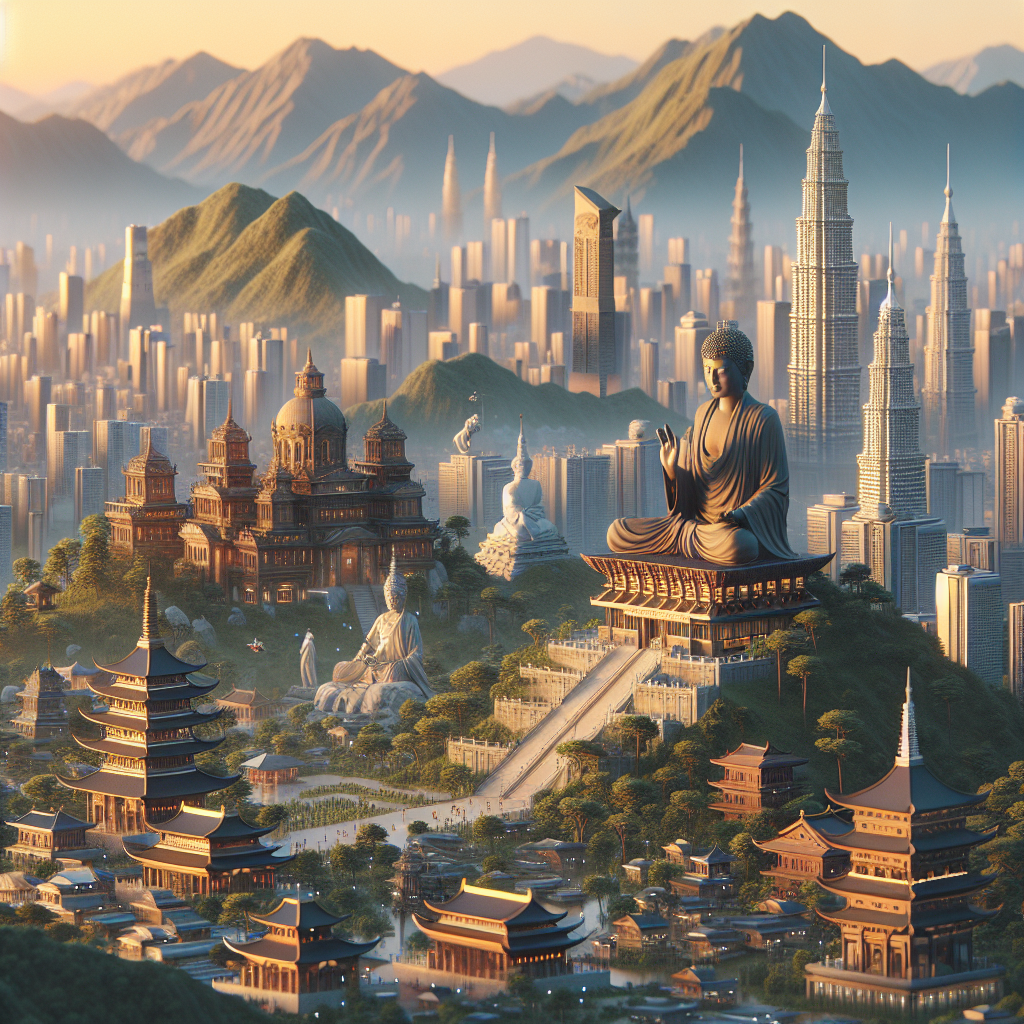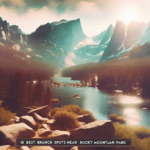Open the Doors to the Koreas’ Kaleidoscopic Culture
Riddle me this: What do you know about Korea, beyond K-Pop and Kimchi? Beneath the global radar, the Korean peninsula – North and South – presents a lush narrative that’s too compelling to ignore. A tale of two countries divided by politics, yet connected by a shared heritage and history. Delve into this mysterious panorama as we unmask some of the unseen treasures, natural nooks, and cultural canvas of both North and South Korea.
Sure, we’ve all heard stories about the two nations, but how much of it goes beyond the stereotypical? Are you intrigued by the untold and the unseen? If your answer is ‘yes’, prepare yourself for a journey of discovery as we explore these nations beyond the headlines and K-dramas.
Stay tuned as we narrate intriguing tales about the distinctive attributes of North and South Korea that have garnered global attention, or simply lurked in the shadows. Expect the unexpected, and challenge your preconceived notions about these captivating lands.
Spotlight on North Korea’s Unseen Treasures
North Korea, a notoriously closed nation, holds a myriad of unique features and phenomena that are admired worldwide. While media coverage focuses largely on politics, this society has more to its name. Let’s dive in and explore some distinctive aspects about North Korea that have gained fame, or perhaps infamy, globally.
Kijong-dong: The Propaganda Village
Near the Demilitarized Zone (DMZ) bordering South Korea, lies the ‘model’ village of Kijong-dong. It is one of the unique places in North Korea catching global attention due to its intriguing back-story.
This village, established in the 1950s, features well-maintained buildings with electric lighting, which was unusual for North Korean rural areas at that time. But, despite these seemingly modern adaptations, the enduring rumor is that it’s uninhabited – a mere showpiece for propaganda purposes.
Kaesong Man’gyŏngdae: The Historic Dynasty
History buffs are likely fascinated by the tales of the Koryo Dynasty (918–1392), the last dynasty of Korean history. The capital city, Kaesong, remains a testament to this era and features on the list of UNESCO World Heritage Sites.
The Royal Tombs
The grandeur of the Koryo era lives on through their royal tombs scattered around Kaesong. Each of these tombs has a distinct architectural style. They provide valuable insight into the cultural history of North Korea and symbolize an era of prosperity and power.
Mass Games: A Stunning Display
Moving into more modern aspects for which North Korea is famous, we find the nation’s mass games. This grand spectacle is a highly organized performance, with thousands of participants creating a remarkable sensory experience.
Arirang Mass Games
One event stands above the rest – the Arirang Mass Games. It has become almost synonymous with North Korea’s cultural display. The event involves over 100,000 performers, stunning gymnastics, synchronized dances, and overwhelming card mosaic pictures created by thousands of participants.
Secretive Cuisine: Pyongyang naengmyeon
North Korean cuisine rarely makes waves in international culinary circles. But, one particular dish that has gained recognition is Pyongyang naengmyeon – cold buckwheat noodles served in a chilled broth with various garnishes. Despite its simplicity, this dish captures the essence of North Korean cuisine, representing a combination of subtlety and depth of flavor.
While North Korea remains somewhat of a mystery to the outside world, these aspects offer glimpses into the nation’s history, culture, and society. Indeed, behind the political headlines, North Korea nurtures a rich tapestry of experiences waiting to be acknowledged and explored.
Navigating North Korea’s Natural Nooks
Peeling back the seemingly impenetrable curtains on North Korea’s society, we find an array of idyllic landscapes and vistas tucked away waiting to be explored. Among these hushed treasures, there are natural landscapes that have held the test of time, providing a vivid vista of North Korea’s untamed beauty.
Mount Paektu: The Sacred Mountain
Arguably the summit of North Korea’s natural beauty, Mount Paektu holds a highly esteemed place in Korean folklore and mythology. The highest mountain in the Korean Peninsula, this majestic peak is also home to the Heaven Lake, or Cheonji, in its caldera, creating a dramatic, almost ethereal landscape.
Heaven Lake and the Crater Wonders
Heaven Lake, with its shimmering blue waters, serves as a sight to behold, often considered the gem of Mount Paektu. Shrouded in Korean legend, this crater lake is amongst the deepest of its kind in the world. Regardless of the season, Heaven Lake always manages to maintain its mystic allure.
Myohyang Mountains: The Fragrant Hills
Named for the fragrant odors that permeate its slopes during spring, the Myohyang Mountains are an integral part of North Korea’s natural splendor. Covered in rich, emerald forests and dotted with ancient Buddhist temples, this range offers unrivaled tranquility.
International Friendship Exhibition
While not naturally occurring, the International Friendship Exhibition nestled within the Myohyang Mountains warrants a mention. This colossal museum, flanked by pristine wilderness, houses gifts presented to North Korean leaders from around the globe, making it a fascinating and surreal element amidst the surrounding natural beauty.
North Korea’s East Coast: A Coastal Refuge
Stretching along the Sea of Japan, North Korea’s east coast is a beautifully secluded retreat. The Wonsan-Kalma coastal tourist area, although developed, sports pristine beaches and quaint waterfronts — a raw testament to North Korea’s understated coastal charm.
Mt Kumgang: The Diamond Mountain
Just off the coast, Mt Kumgang, well-known as the Diamond Mountain, offers panoramic views of granite peaks interspersed with crystal-clear lagoons. The area, replete with waterfall-filled valleys and serene hiking trails, illustrates the untouched beauty of North Korea’s mountainous terrain.
The Hidden Wilderness: Rason Special Economic Zone
At the northeastern tip of North Korea, the Rason Special Economic Zone presents an array of natural wonders, including wetland reserves teeming with biodiversity. From its wild beaches to birdwatching hotspots, this zone wonderfully epitomizes North Korea’s rich natural essence.
Pipha Island and its Beaches
Resting within this economic zone, Pipha Island is a small, uninhabited islet that boasts pristine beaches and stunning sunsets over the Sea of Japan. Although largely antithetical to the usual narrative surrounding North Korea, this idyllic setting is a prism reflecting the nation’s serene beachside beauty.
This exploration into North Korea’s scenic landscapes showcases the beauty that saturates its land, often overshadowed by global perceptions. Providing an intimate perspective on the nation’s aesthetics, it’s clear that North Korea’s landscape brims with captivating natural beauty and fascinating sights, rich in cultural and historical significance.
Unraveling the Magnetic Allure of South Korea
Frequently overshadowed by its northern counterpart, South Korea nonetheless offers its own mesmerizing mix of modern marvels, ancient legacy, and stunning landscapes. For tourists looking for a unique blend of culture, history, and natural beauty, South Korea does not disappoint.
Seoul: The Bustling Metropolis
Standing out as South Korea’s crowning glory is its thriving capital city, Seoul. Packed with soaring skyscrapers, vibrant night markets, and serene Buddhist temples, Seoul perfectly encapsulates the nation’s harmony of tradition and modernity.
Namsan Seoul Tower: The City’s Crown Jewel
One of Seoul’s most prominent landmarks, the Namsan Seoul Tower, provides panoramic views of the sprawling cityscape. Few can resist the allure of the Love Locks, where couples leave padlocks to symbolize their enduring love. The tower’s digital observatory, with its immersive media displays, gives visitors a unique view into the city’s evolution.
Busan: The Coastal City
Busan, South Korea’s second-largest city, often leaves its visitors spellbound with its stunning combination of scenic coastlines and urban charm. The city’s picturesque beaches, bustling seafood markets, and the flourishing art scene make it a must-visit destination in South Korea.
Haeundae Beach and the Marine City
Haeundae Beach, one of Busan’s most popular attractions, is celebrated for its long stretch of sand, crystal-clear water, and nearby skyscrapers. In the Marine City, you’ll find a cluster of luxury high-rises, shopping areas, and gourmet eateries, bestowing the area with a distinctly cosmopolitan feel.
Jeju Island: The Island of the Gods
Jeju Island, often referred to as the “Island of the Gods”, is by far South Korea’s most renowned tourist hotspot. Blessed with balmy weather, lush countryside, and picturesque beaches, it’s little wonder why Jeju Island has been designated a UNESCO World Natural Heritage site.
Seongsan Ilchulbong and Jeju Volcanic Island
Jeju Island is famous for Seongsan Ilchulbong, also known as Sunrise Peak, a volcanic tuff cone and one of Jeju’s most iconic landmarks. It serves as the perfect spot for watching breathtaking sunrises. Must-see places include the largest lava tube in the world, Manjanggul Cave, and the odd-shaped rocks at Jusangjeolli Cliff.
Muju Ski Resort: Winter Wonderland
The Muju Ski Resort is South Korea’s premier ski destination. Nestled in the Deogyusan Mountains, this resort boasts superb snow conditions and top-notch facilities, winning the hearts of winter sports enthusiasts worldwide.
Winter Sports Galore
Muju offers a sensational selection of winter sports facilities, from ski slopes catering to various skill levels to well-maintained snowboarding areas. For those seeking something more relaxed, there are opportunities for scenic gondola rides and tranquil hot springs baths.
Rife with cultural treasures, breathtaking landscapes, and bustling cityscapes, it’s no surprise that South Korea continues to climb the ranks of must-visit countries. Whether you’re a history aficionado, a gastronomic adventurer, or a fan of the great outdoors, South Korea’s diverse tourism offerings will leave you spoilt for choice.
Diving Deeper into North Korea’s Cultural Canvas
North Korea, known for its enigmatic character, holds various cultural elements that offer an exploration into its rich cultural tapestry and diverse history. From significant structures to unique folklore, the nation relishes in its unique blend of ancient and modern customs.
Ryugyong Hotel: The Unfinished Giant
Located in the capital city of Pyongyang, the Ryugyong Hotel has become an iconic representation of North Korea on the global scale. This massive structure, reaching a height of 330 meters, boasts an impressive 105 floors. Despite being unfinished, it stands as a remarkable symbol of ambition.
Pyongyang Metro: Art Beneath the Surface
While transportation systems are often seen as functional necessities, the Pyongyang Metro is a cultural testament. Many of its stations are adorned with beautiful murals and mosaics that depict themes of North Korean society, politics, and history – turning a commute into a distinct cultural journey.
Art Reflects Societal Values
In the Pyongyang Metro, each station holds unique artistic expressions that articulate North Korea’s value system and historical narrative. Artistic portrayals extend from scenes of the Korean War to visuals of everyday life – providing a much-needed insight into the country’s societal fabric.
Juche Tower: Beacon of Self-Reliance
The Juche Tower stands tall over Pyongyang, reflecting the national political philosophy of Juche, essentially meaning “self-reliance.” This commandment of domestic autonomy continues to deeply influence the nation.
Juche Philosophy Embodied
As a tangible manifestation of North Korea’s political beliefs, the Juche Tower reaches a height of 170 meters, symbolizing the enduring legacy of the Juche ideology. Tourists can climb the tower for a panoramic view of the city and its imposing structures.
Exploring South Korea’s Vibrant Traditions
South Korea’s rich cultural heritage is as remarkable as its modern marvels. From traditional temples to colorful festivals, the nation offers an irresistible charm that sings their history, traditions, and customs beautifully.
Gyeongbokgung Palace: Royal Grandeur
Gyeongbokgung, one of Seoul’s five main palaces, is a magnificent testament to the royal architectural traditions of South Korea. Its beautifully manicured gardens, vast courtyards, and ornate structures offer a captivating journey into the nation’s regal history.
Changing of the Guard Ceremony
The Gyeongbokgung Palace ‘Changing of the Guard’ ceremony is a vibrant event that displays the royal culture’s tradition. Witnessing the colorfully attired guards in their ceremonial exchange offers a captivating snapshot of this significant historical practice.
Bukchon Hanok Village: Living History
Located in the heart of Seoul, Bukchon Hanok Village transports visitors back in time with its narrow alleys, traditional houses called hanoks, and a quiet charm distinctly separating it from Seoul’s bustling city life.
Experience Hanbok and Hanok
Visitors to Bukchon Hanok Village can not only admire the stunning traditional architecture of hanoks but also get a chance to wear the traditional Korean dress, hanbok. This immersive experience brings Korea’s past to life in a vivid and tangible way.
Lotte World Tower: Touching the Sky
The Lotte World Tower, a modern luxury, stands as the tallest skyscraper in South Korea. Beyond its business and residential spaces, this iconic structure also presents world-class entertainment, shopping, and dining experiences.
Sky-High Recreation
Restaurants, movie theaters, and even a concert hall distinguish Lotte World Tower as more than just an architectural spectacle. On top of these, Seoul Sky, the observation deck, offers breathtaking views of the city skyline from dizzying heights.
Undeniably, both North and South Korea offer a diverse blend of ancient and modern experiences. Their distinct cultural, historical, and societal aspects paint fascinating pictures of these two countries. Whether it’s North Korea’s strict self-reliance or South Korea’s balance of tradition and innovation, there is much to discover and appreciate.
A Final Peek into North Korea’s Distinctive Tapestry
Despite the shroud of intense security and the reputation surrounding its socio-political scene, North Korea’s unique blend of historic grandeur and modern spectacle paints a fascinating picture. Its captivating amalgamation of historical remnants such as the mysterious Kijong-dong and the grandeur of the Koryo Dynasty’s royal tombs, the dynamic display presented by mass games like the iconic Arirang, and even the simplistic yet delicious Pyongyang naengmyeon, all contribute to elucidating an unseen side of North Korea. These distinctive aspects of North Korean life invite the curious to look past the headlines, edging towards a better understanding of a society that remains largely secluded from the world’s gaze.
Regardless of the opinions and impressions formed by the global community, influences from historical, cultural, and even culinary perspectives highlight the multi-dimensional character of North Korea. These aspects are inseparable from their context, standing as silent relics of time past or glowing symbols of a cultural fabric woven over centuries. They serve as a reminder that underneath the geopolitical controversies, there is a nation imbued with rich experience, much of which is waiting to be discovered and explored.







